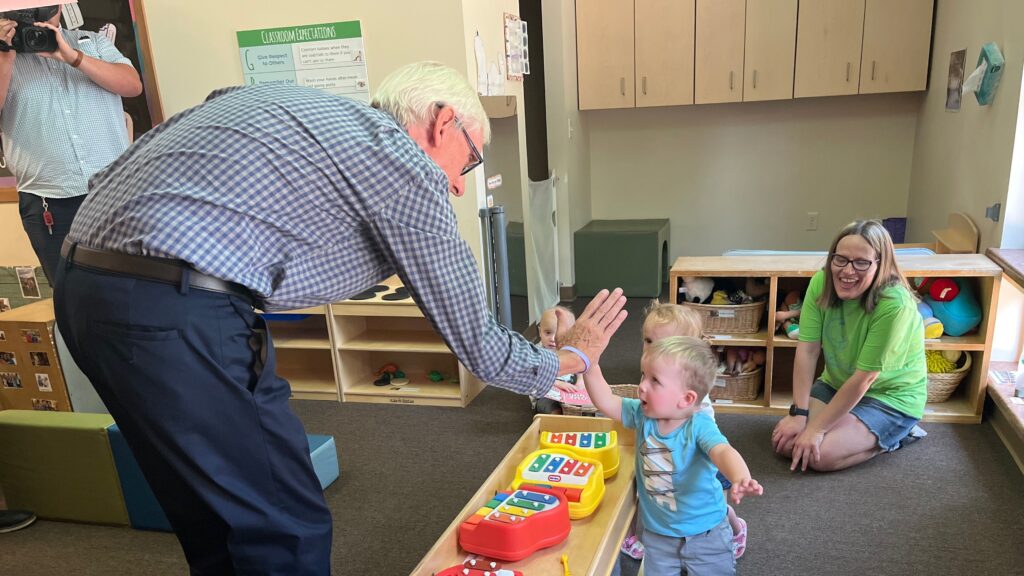Child Care Providers ‘Reeling,’ Need Funding
Legislature has ignored Gov. Evers' proposals to replace lost pandemic funding.

Gov. Tony Evers interacts with children during a visit to a child care center in Menomonie on Wednesday, Aug. 2. Photo courtesy of Gov. Tony Evers’ office.
It’s been a month since Wisconsin’s state budget took effect, without more than $300 million that providers and families had counted on to help sustain child care services over the next two years.
With the prospect of that continued support uncertain, “child care programs right now are reeling,” said Ruth Schmidt, executive director of the Wisconsin Early Childhood Association (WECA). They are “just trying to make decisions and figure out, ‘Am I raising my rates? By how much? … Am I laying off staff? Am I reducing wages? Am I going to stop taking a wage myself as the owner of this program?’”
Providers and their allies, including Gov. Tony Evers, see only one way out of the mounting crisis — a massive re-do by the state Legislature: reopening the 2023-25 state budget that Evers signed a month ago to add $340 million that the Legislature’s Republican majority left out of the final spending plan.
Visiting a Menomonie child care center last week, Evers told local media that he hasn’t ruled ot calling a special session of the Legislature to address the need for more child care money. On Friday, Madison TV station Channel 3000, WISC-TV, aired a report citing anonymous sources suggesting that a special session might be the subject of a news conference the governor plans to call on Tuesday.
To date, the Legislature has not taken up any of Evers’ proposed special session initiatives on topics ranging from gun violence to school funding to reproductive rights.
Reviving Child Care Counts
The $340 million that Evers and child care advocates seek would continue for the next two years monthly subsidy grants to child care centers across the state. The subsidy grants, known as Child Care Counts, began during the COVID-19 pandemic and were covered by federal pandemic relief funds.
Through May of this year, the state has distributed $20 million each month to child care centers. The funds were cut in half starting in June and will run out entirely by January 2024.
Child care center operators say the money made it possible for them to raise wages for child care workers while not increasing tuition. Providers and advocates say better wages have been essential to enable child care providers to recruit enough qualified employees. Holding down tuition costs has been equally critical: On average, child care already costs Wisconsin families more than $12,500 a year, according to the Economic Policy Institute.
In the Columbia County community of Portage, Debbie Drew is the administrative manager for the church-affiliated St. John’s Child Development Center. Drew says her staff’s wages are the highest for providers in the county, but her employees include parents who qualify for Wisconsin Shares, the state’s child care subsidy program for low-income families.
“I have two employees that get off work at 3 o’clock to make sure they make it to the food bank,” Drew said.
Meanwhile, parents pay $300 a week on average to have children in the center’s care. Drew acknowledges that wages should go up, but she doesn’t see how tuition can rise to meet the added cost of higher pay.
“How is a parent to pay more than $300 a week in Columbia County?” she said. She worries that if the cost goes too high, parents will wind up forgoing child care, leading them to drop out of the workforce.
In a report earlier this year, the nonpartisan Wisconsin Policy Forum concluded that “absent external investments or interventions, the cost of quality can quickly erode operators’ sustainability and further strain families’ budgets without providing compensation to child care workers that reflects the social and economic importance of their work.”
Child Care Counts has provided those “external investments” over the last two years, advocates say — and was aimed at preserving them in the state budget for the next two.
Governor’s statewide push
When he signed the budget July 5, Evers wrote, “The Legislature must make the substantial investments necessary to stabilize our state’s child care industry and ensure child care is affordable and accessible so we can keep parents in our workforce.”
The Menomonie child care center that Evers visited last week was just one of a half-dozen or so around the state that he has toured over the last three weeks. On his visits, Evers has garnered local media attention while reiterating his call for the Legislature to restore his $340 million proposal. He repeated the appeal in his weekly radio address July 27.
“If the Legislature fails to address the looming child care crisis facing our state, a recent report estimates that 2,110 child care programs could close their doors, we could lose over 4,800 child care jobs, and over 87,000 children could be left without care,” Evers said. “Folks — that would be a catastrophe for our state’s economy, workforce, and businesses, potentially causing about half a billion dollars in economic impacts across our state.”
Corrine Hendrickson, a New Glarus family child care provider and one of the organizers of an advocacy group, Wisconsin Early Childhood Action Needed (WECAN), says she’s been hearing from operators who are already going out of business — some in anticipation of the loss of Child Care Counts money entirely in January, and others because of the 50% cut that began in June.
Data that WECAN requested from the Wisconsin Department of Children and Families (DCF) showed a spike in child care closings in June and July. That comes after child care closings “had slowed dramatically” in the last three years, Hendrickson said, because of the waves of pandemic relief money that helped stabilize providers. “And now it’s increasing right back up.”
The numbers are still anecdotal, however. Gina Paige, director of communications at DCF, confirms that in the six weeks from mid-June through the end of July, 32 centers “may have closed due to the child care crisis.”
Other closures during that time should be excluded, she said, because they involved centers with a revoked credential or centers listed as “closed” when they simply changed a license category. Even the 32 closures that Paige said might be due to the looming loss of state financial support could include centers with other circumstances unrelated to the fiscal straits.
It’s also not clear yet how many children or their families have been affected by the most recent closures. On paper those same 32 centers had a licensed capacity for 1,275 children, according to DCF records. “It does not mean that they were operating at the number” listed, however, Paige said. “Many facilities operate at lower numbers due to staffing, demand and other factors.”
Worsening dilemma
Advocates agree, however, that none of those nuances minimize the continued, and likely worsening, dilemma for child care providers.
“Without a substantial investment from the state, like those proposed in Governor Evers’ biennial budget, our state faces ongoing child care shortages that will impact our economy,” Paige told the Wisconsin Examiner via email.
Sarah Kazell, an advocate at the Supporting Families Together Association, an umbrella organization for child care referral services, said outside support will be critical to the survival of accessible and affordable child care.
“Without a direct payment program like Child Care Counts injecting a financial lifeline into the broken child care market, we know that a predictable series of outcomes will occur,” Kazell said. “The already inadequate supply of child care will dramatically decrease, tuition prices for available programs will skyrocket, and ultimately more parents will be forced out of the workforce, circumstances projected to cost our state’s economy billions.”
St. John’s in Portage offers a case study in how staffing, worker pay scales and affordability all become entangled in the struggle for child care access.
Before the COVID-19 pandemic, the center had multiple programs for preschool, kindergarten, infants and toddlers that were full and had waiting lists, Drew said. From eight programs, the center is down to five, “and all classrooms are at half capacity,” said Drew. Once licensed for 105 children, the center reduced its official capacity to 75 because it no longer had enough staff to cover the higher number. This coming week, however, just 27 children are enrolled, Drew said Friday.
That’s not because there’s no demand. “I’m in a community that very much needs this center,” she said. Drew has lost seven employees in recent months, people who have left for higher wages at convenience stores or other jobs. And she said she had to let go three newly hired teenagers after seeing they weren’t prepared for the responsibilities the work involves.
Preliminary results of a new survey from the Wisconsin Early Childhood Association of 520 Wisconsin child care providers shows a dramatic shift from less than a year ago, said Schmidt, the WECA director.
In the Wisconsin portion of a national survey conducted last year by the National Association for the Education of Young Children (NAEYC), 61% of Wisconsin child care operators said they would consider raising their tuition when pandemic relief support ended.
In WECA’s new survey, “87% are indicating that they are considering raising their rates,” said Schmidt, “which is dramatically increased from what was found in the NAEYC study.”
The new survey also recorded 32% of providers who said they are considering closing their programs. Schmidt said that would potentially cause up to 19,000 Wisconsin families to lose child care.
For some providers thinking they’ll have to close, the prospect is directly linked to their need to hike tuition. “A lot of what we’re hearing back is that ‘Families will not be able to afford my new rate, and therefore I will not be able to fill my slots and have to close,’” Schmidt explained.
In the 2022 survey, one in three child care workers said they were leaving their jobs or thinking about doing so because of providers’ financial straits. In WECA’s new survey, that figure is up to 48%.
It remains to be seen if people follow through, Schmidt said. But, she added, “it does show a dramatic shift in the current thinking.”
Child care providers ‘are reeling’ as they wait for state to try again for financial support was originally published by the Wisconsin Examiner.
If you think stories like this are important, become a member of Urban Milwaukee and help support real, independent journalism. Plus you get some cool added benefits.



















